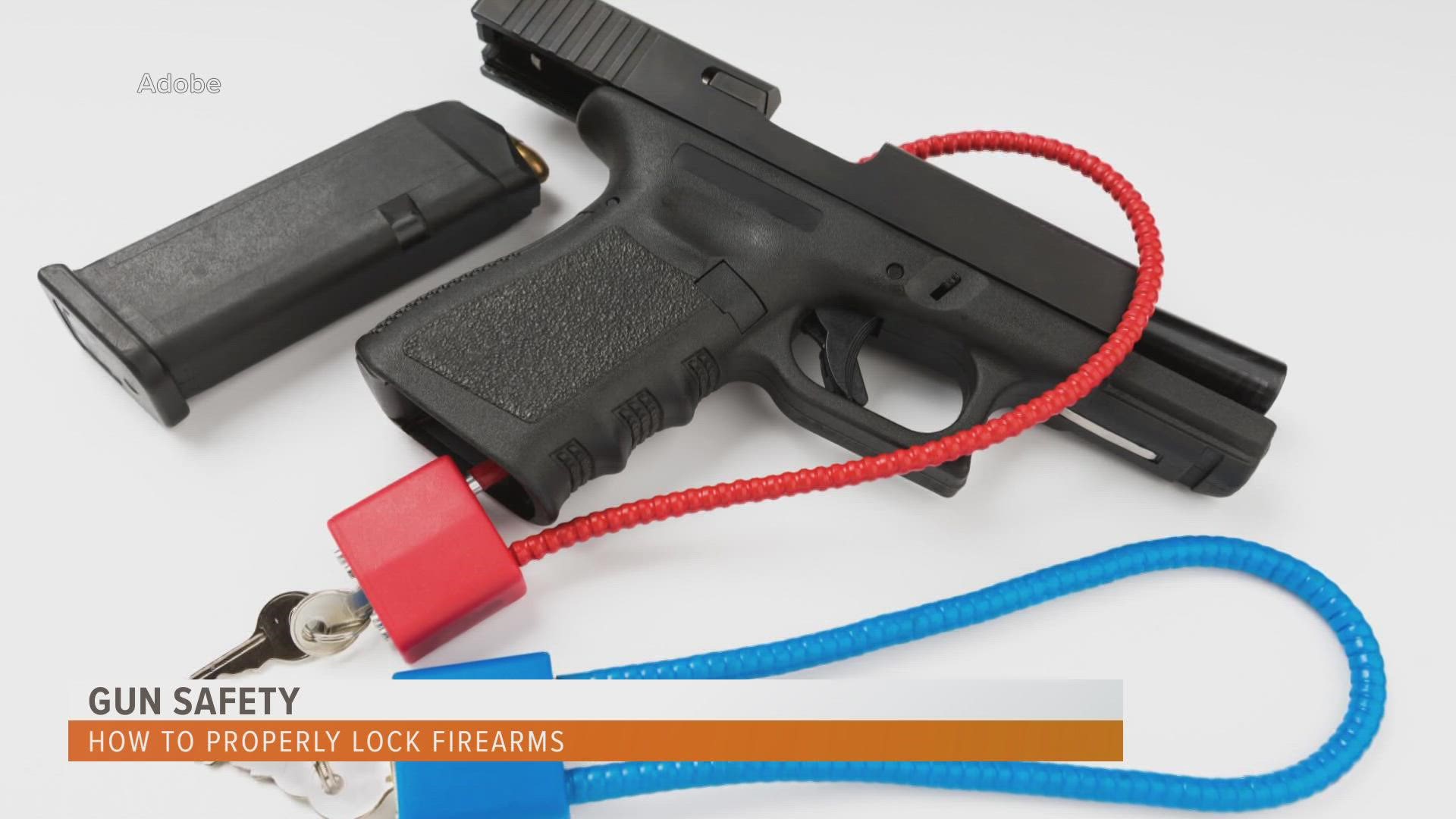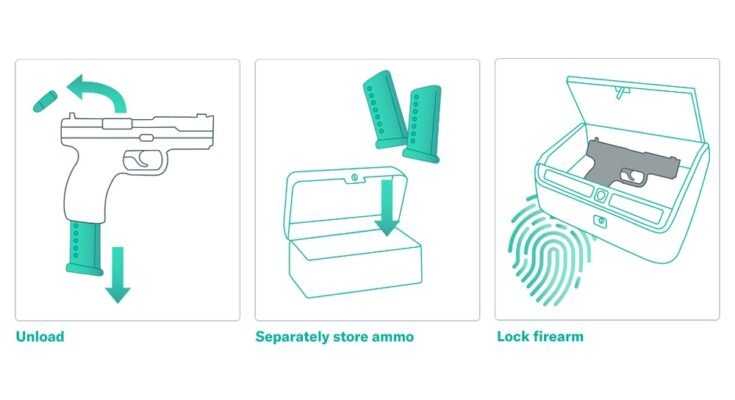If you own a gun cabinet, you know how important it is to keep your firearms safe and secure. But simply having a cabinet is not enough—you need to lock it properly to protect your guns from unauthorized access.
You might think it’s straightforward, but many people make simple mistakes that leave their cabinets vulnerable. You’ll discover easy and effective steps to lock your gun cabinet the right way. By the end, you’ll have the confidence that your firearms are stored safely, giving you peace of mind.
Keep reading to learn how to protect what matters most.

Choosing The Right Gun Cabinet
Choosing the right gun cabinet is key to keeping firearms safe. It protects your guns from theft and limits access to unauthorized people. A good cabinet fits your needs and provides strong security. Consider important factors before buying.
Material And Build Quality
Strong materials make a cabinet tough to break. Steel is common because it is hard and durable. Cabinets with thick walls resist drilling and cutting better. Look for cabinets with solid welds and quality hinges. Avoid thin or weak materials that can fail easily.
Size And Capacity
Pick a size that fits your guns comfortably. Make sure it holds all your firearms without crowding. Some cabinets have shelves or racks for ammo and accessories. Think about future purchases. A cabinet with extra space saves money later.
Locking Mechanisms
A secure lock is the heart of any gun cabinet. Mechanical locks like combination dials do not need batteries. Electronic locks offer quick access but need power. Some cabinets use key locks, but keys can be lost. Choose a lock type that matches your security needs and comfort.

Essential Security Features
Securing a gun cabinet properly requires more than just a simple lock. Essential security features make the cabinet harder to open by unauthorized people. These features help keep your firearms safe and out of reach from children or burglars.
Tamper-resistant Locks
Tamper-resistant locks are built to resist picking and forced entry. They use strong materials and complex designs. This type of lock increases security by preventing easy break-ins. Electronic locks with keypad or biometric access also add protection.
Reinforced Hinges
Reinforced hinges strengthen the cabinet door against attacks. They are often made from heavy-duty steel. Some hinges are hidden to avoid being removed. Strong hinges keep the door secure even if the lock is damaged.
Alarm Integration
Alarm integration adds an extra layer of security. Sensors detect if the cabinet is opened without permission. The alarm alerts you or triggers a security system. This feature can stop theft or unauthorized access quickly.
Installation Tips For Maximum Security
Installing a gun cabinet properly is key for keeping firearms safe. Secure installation stops easy theft and prevents accidents. Follow these simple tips to boost your cabinet’s security. Each step matters for a strong, reliable setup.
Selecting The Location
Pick a hidden spot that is hard to access. Avoid places near windows or doors. Choose a dry area to prevent rust or damage. A closet or a room corner works well. The location should be out of children’s reach.
Anchoring The Cabinet
Secure the cabinet firmly to a wall or floor. Use heavy-duty screws and anchors made for your wall type. Check the cabinet’s manual for recommended hardware. Tighten all bolts to stop any movement. A loose cabinet can be pulled away easily.
Avoiding Common Mistakes
Do not place the cabinet on a weak surface like drywall only. Avoid using short screws that do not hold well. Don’t install the cabinet too low or too high. Keep keys or combinations separate from the cabinet. Regularly check locks and hinges for wear or damage.
Best Lock Types For Gun Cabinets
Choosing the right lock for your gun cabinet is key to keeping firearms safe. Different lock types offer varying levels of security and ease of use. Understanding these options helps you pick the best one for your needs.
Mechanical Locks
Mechanical locks use keys or combination dials to secure the cabinet. They are reliable and do not need batteries. These locks are simple to use and often cost less than other types. Mechanical locks work well for basic security.
Electronic Keypads
Electronic keypad locks allow you to enter a code to open the cabinet. They provide faster access than mechanical locks. You can change the code anytime for added safety. These locks require batteries but offer good protection.
Biometric Systems
Biometric locks use fingerprints to grant access. Only registered users can open the cabinet. This type offers high security and quick entry. They need power to function and may cost more but are very effective.
Maintaining Your Gun Cabinet Lock
Maintaining your gun cabinet lock is vital for safety and security. A well-kept lock prevents unauthorized access. It also ensures the lock works smoothly every time you use it. Neglecting maintenance can cause the lock to jam or fail.
Simple care steps keep your lock reliable. Regular checks and small fixes save you from bigger problems later. Here are key ways to maintain your gun cabinet lock effectively.
Regular Inspection
Check your gun cabinet lock every few months. Look for signs of rust or damage. Test the lock to ensure it opens and closes easily. Notice any stiffness or unusual sounds. Early detection of issues helps avoid lock failure.
Lubrication Techniques
Use a dry lubricant or graphite powder on the lock mechanism. Avoid oil-based lubricants as they attract dust and dirt. Apply a small amount directly into the keyhole. Turn the key gently to spread the lubricant evenly. This keeps the lock smooth and prevents sticking.
Updating Security Features
Upgrade your lock if it shows wear or becomes outdated. Consider modern locking systems like combination locks or electronic locks. These provide added security and ease of use. Regular updates help protect your firearms against theft.
Additional Safety Measures
Keeping a gun cabinet locked is very important. But taking extra safety steps can protect your home even more. These measures help prevent accidents and keep guns away from people who should not use them.
Storing Ammunition Separately
Keep ammunition in a different, locked place. This makes it harder for anyone to use the gun. Store ammo in a cool, dry spot away from the gun cabinet. This step lowers the risk of accidents and theft.
Using Secondary Locks
Add another lock to your gun cabinet. Use a padlock or a cable lock inside the cabinet. This double lock system adds more protection. It makes it harder for anyone to open the cabinet without permission.
Educating Household Members
Teach everyone in your home about gun safety. Explain why guns must stay locked and safe. Make sure children know not to touch guns. Education helps avoid accidents and keeps the family safe.
Legal Considerations For Gun Storage
Storing guns safely is not just about protecting your firearms. It also means following the law. Many places have strict rules about how to store guns. These rules help prevent accidents and keep everyone safe. Knowing these rules helps you avoid trouble and keep your home secure.
State And Local Regulations
Each state has its own laws about gun storage. Some require locked cabinets or safes. Others may ask for trigger locks or separate ammo storage. Local rules can add more rules on top of state laws. Check your area’s laws carefully. This helps you know exactly what is legal.
Liability Issues
Gun owners can face legal trouble if guns are not stored properly. If a child or unauthorized person gets a gun, the owner can be held responsible. Courts often look at how secure the storage was. Proper locking can reduce the risk of lawsuits or fines.
Safe Storage Compliance
Following safe storage rules is key to legal compliance. Use strong locks and secure cabinets. Keep keys or combinations private. Regularly check your storage to ensure it stays secure. This simple care helps meet legal standards and protects your family.

Frequently Asked Questions
How Do I Securely Lock A Gun Cabinet?
Use a high-quality lock like a biometric or combination lock. Ensure the cabinet is sturdy and fix it to a wall or floor for added security.
What Types Of Locks Are Best For Gun Cabinets?
Biometric, combination, and high-grade keyed locks offer strong security. Choose one that fits your usage and provides quick access when needed.
Why Is Locking A Gun Cabinet Important?
Locking prevents unauthorized access and enhances safety. It reduces risks of theft, accidents, and complies with legal storage requirements.
Can I Use A Padlock On My Gun Cabinet?
Yes, but choose a heavy-duty padlock with a hardened shackle. Ensure the cabinet has proper hasps designed for padlocks.
Conclusion
Securing your gun cabinet keeps your firearms safe and away from harm. Always choose a strong lock and check it often. Place the cabinet in a hard-to-reach spot. Keep keys or codes private and never share them. Taking these steps protects your family and your guns.
Safety starts with simple, careful actions. Stay responsible and protect what matters most.



